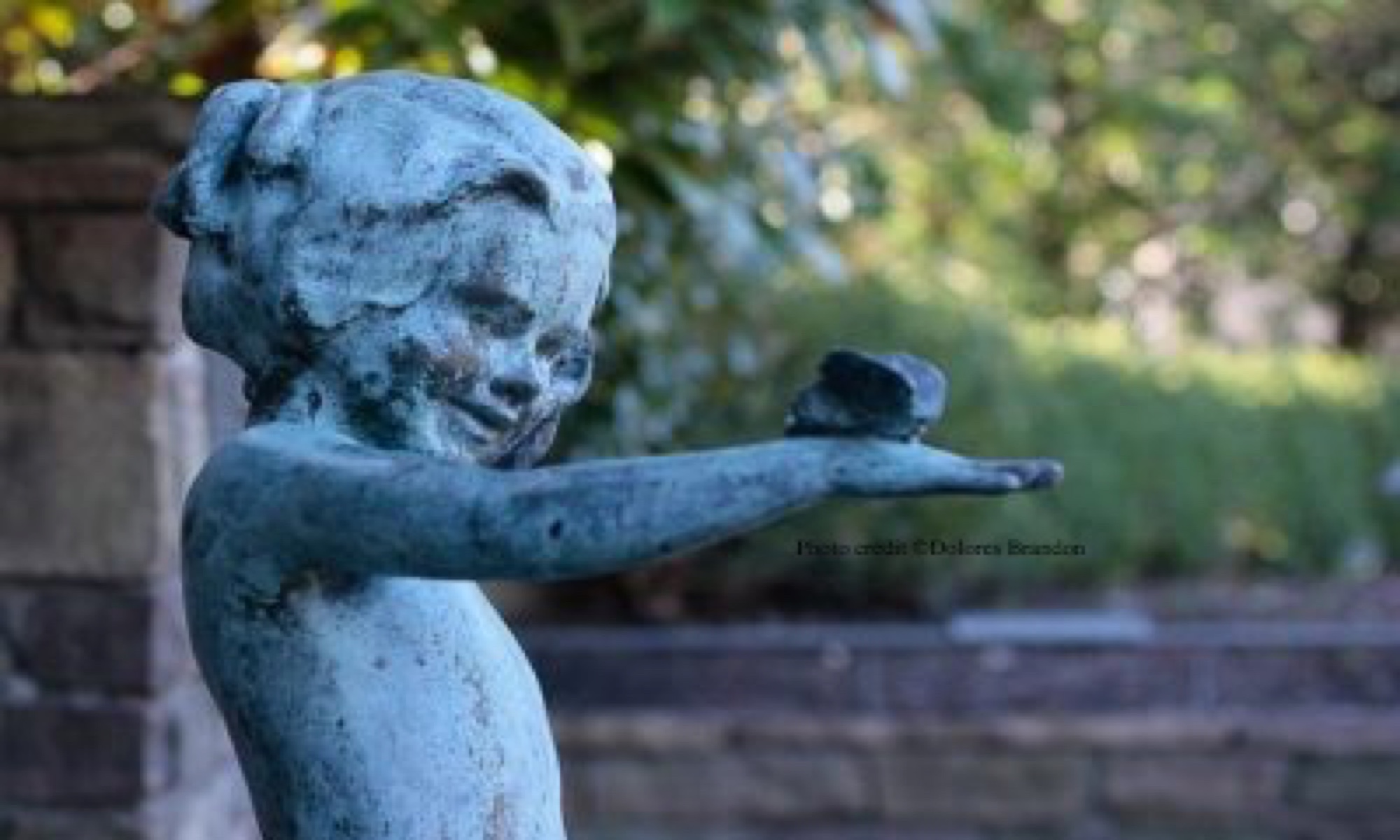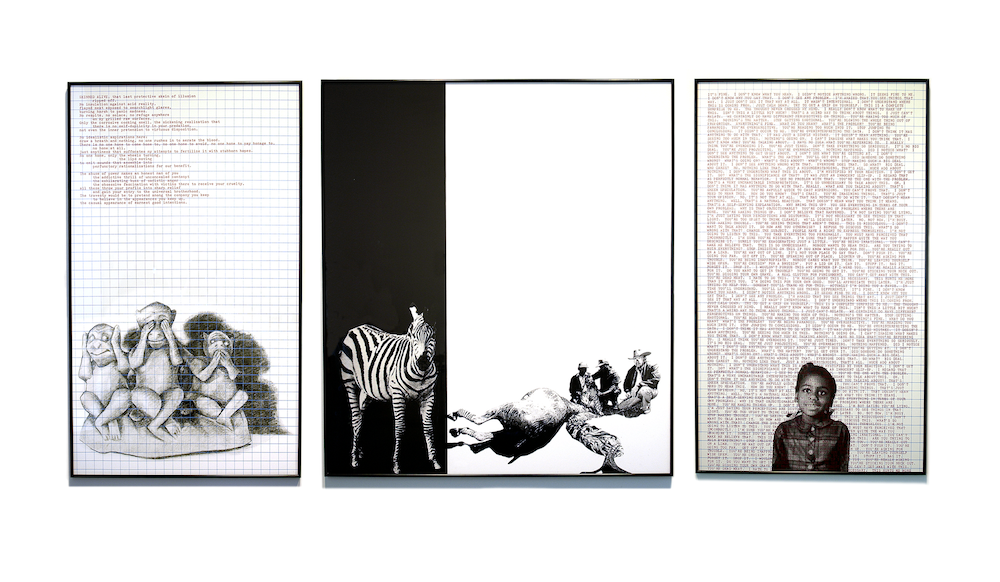Decide Who You Are (1992)
Adrian Piper, Decide Who You Are #1: Skinned Alive, 1992. Silkscreened image-text collage printed on paper mounted on foam, silkscreened text. Three panels: 72 x 153″each, (182.8 x 388.6 cm). Private Collection, USA. © Adrian Piper Research Archive Foundation Berlin.
Decide Who You Are is a huge multi-faceted, multi-media exhibit through which Piper explores “two interconnecting themes: class conflict and academic issues relating to class conflict and class elitism particularly with regard to race”.
The following radio feature (produced for CROSSROADS/NPR) profiles Adrian Piper and that exhibit.
Dolores Brandon Features Adrian Piper, October1992. 00:05:04, Program: Crossroads, (Executive Producer – Elisabeth Perez-Luna; Distributor – National Public Radio 1992).
The various elements of this series were curated for simultaneous display across three venues in New York City – The PAULA COOPER Gallery, the JOHN WEBER Gallery and New York University.
By pure coincidence DECIDE WHO YOU ARE with its references to Anita Hill ran as media worldwide was vigorously revisiting the Clarence Thomas confirmation hearings controversy of 1991.
Adrian Piper at work in the APRAF, Berlin, Germany Photograph by Jason Schmidt
Adrian Piper brings a stunning breadth of talent and education to her professional life. Highly accomplished not only in the realm of multi-media artistic expression – at 20 she was among the first generation of conceptual artists working in New York in the late 1960s – Piper also has a PhD in Philosophy from Harvard. Equally at home in academia and publishing, fluent in several languages, Piper is internationally recognized for her work in both philosophy and art.
Dolores Brandon Interviews Adrian Piper (Highlights). Highlights excerpted from unpublished interview, October 7, 1992.
In this interview Piper describes some of the challenges her biracial identity and dual career path have posed not only in general society, but also in art and academic circles.
Dolores Brandon (DB): Please give us an overview of the themes explored in the DECIDE WHO YOU ARE series.
Adrian Piper (AP):
[The work addresses] two interconnecting themes: class conflict and academic issues relating to class conflict and class elitism particularly with regard to race. Some pieces explore the difficulties [arising as a result of efforts to integrate] educational settings. Some pieces are specifically critical of President [George H.] Bush, his family, the Bush administration. There are images of local riots and police; there’s an image of a chronometer watch, one of those ads that appeal to one’s snobbish, class interests – ‘dress with the best’ sort of thing. And then there’s one about the transmission of values from generation to generation through children in very advantageous social settings. So, there are lots of different kinds of things.
In a certain sense, it’s overtly political, but it really is about exposing and naming class interests, and also expressing the point of view of someone whose been excluded from the resources and advantages of that kind of life.
DB: The text that [fills the ground] behind the picture of Anita Hill, where does that come from? Was it taken from the transcripts [of the Clarence Thomas hearings]?
AP: No. That text was one that I constructed: I tried to construct it out of every dismissive marginalizing peremptory dismissal I’ve ever heard anyone say about anything. You know how when you’re trying to express something or communicate an
observation or feeling and someone doesn’t want to hear it
they’ll shunt it aside with – ‘oh that doesn’t matter, oh, you’re just seeing things, that’s not important, that doesn’t mean what you think it means’ ?
DB: Was Anita Hill the prompt around which DECIDE WHO YOU ARE focused or did she just appear and happen to fit in?
AP: She appeared and happened to fit it. In fact, it was really that [one] particular photograph of her at the age of eight years old that was the key for me. I’ve seen other photos of her as an adult and she has great poise, and a great sense of presence,is very stately, and I think a very beautiful woman, very wise looking in a certain way. But what struck me about the photograph of her at the age of eight was the openness, the sense of vulnerability, and the sense of not feeling any fear about being who she was. No fear, no shame no sense of inhibitions. That photograph of her as a child in part explains why she had the courage and strength to do what
she did as an adult. She was not trained to be afraid or censor herself.
It’s important to couple that image with the words, and sound of the benevolent censor who says ‘that doesn’t mean what you think it means, that’s not real important, big deal’: you know, the voice that attempts to diminish her vision and her perception and ignore them in certain ways that I felt were just a very good match [for what I was interested in exploring].
DB: On the other side of the panel – [the image of the proverbial three monkeys – [see no evil, hear no evil, speak no evil]: with that you address the tendency to self-censorship which can be and is such a virulent element within so-called civilized society. It seemed to me that you in fact with your work you have blasted through in spite of the very real social pressures to be one of those monkeys and that’s where the real triumph is.
AP: Thank you for saying that. That was what I meant to do, and what wanted to do. I’m delighted that that came across.
DB: I also felt throughout the work that you were giving voice to the voiceless – particularly with the images of the animal world, [as in the Skinned Alive image]. Was that your intention?
AP: Sort of. It wasn’t a specific intention to speak for animals, but it was an intention to express what I feel, and what I feel animals feel about being hunted and slaughtered. Those are important topics to me. It wasn’t that I simply think that we should treat animals kindly and we shouldn’t harm them but also that we ourselves are animals, and there is something we have in common with animals: we, in fact, know what it is like to be hunted, we know what it’s like to be slaughtered, and I wanted to give voice to that commonality. They can be metaphors or they can [simply] be the things that are actually [depicted].
DB: The title is an imperative – DECIDE WHO YOU ARE. I’d like you to expand on that imperative.
AP: Yes. I’ve been using this first second person I/You form of address, this very personal immediate form of address in my work since about 1971; and very often when people see my work they say “Well, who’s the you here” as if to say “Who, me? Are you talking to me?” So there’s a lot of fence sitting and people may feel that they are being targeted and they don’t like that. Or that they are being identified and they don’t want to be highlighted in
that way. How a person identifies him/her self, whether they identify with the you or with the I, depends on where they are; depends on what they’re going through at the moment. But 1 was very interested in sort of asking viewers to make that decision for themselves. It’s not for me to decide who the you is, it’s for the viewer to decide whether the you is yes you, or whether it doesn’t apply at all. Another title for the series could have been – DECIDE WHO THE YOU IS. Also, I was very interested in getting past that dichotomy.
DB: How did you come to [conceive of the video you title] CORNERED (1988)?
AP: It had a lot to do with feeling cornered, it really did.
I’ve been trying to figure out what is the right way to deal with the issue of racial identity for a very long time because in the oversimplified American racial scheme of things, there is just no room for someone [biracial who is often taken for white] like me. So, people are always getting surprised or shocked or feeling offended or tricked when they find out that I am black. I really felt that 1 had to come to grips with it; I had to dissect it and spell it out and make clear to those around me the implications of racial identification as it functions in this country. Somehow I felt I really had to spell things out so we were all clear on the situation. And that’s how that piece came about. It came from a very personal place. I felt I was really backed into a corner whether I announced my racial identity, or said nothing, or intimated it. There’s no right way of dealing with it, and so that’s why I did that
DB: So, they’re saying in effect {that art world insists] your work has to tell us that you’re black?
AP: That’s right.
DB: And if it doesn’t, they’re not going to show it because people will be disappointed when they find out?
AP: (Laughter) strange business!
I do whatever I can to remind people that there is this other side of me: I am not just the race lady who deals with issues of racial identity; there is other work. I’ve had this discussion a number of times with people, curators who have wanted to show my work; I’ve had now a few traveling retrospectives of my work, and very often curators want to start with the work of the early 70s because it’s political work they’re interested in. And I simply refuse to show any work in what purports to be a comprehensive retrospective unless it includes the first generation conceptual work – the kind of pure metaphysical philosophy of language style of work I was doing in the late 60s, and I’ve had to insist on that. When people write about my work they almost never mention that, and when people write about first generation conceptual art in general they almost never mention me. I’m always having to make a fuss about that. Recently there was a very comprehensive group exhibition of first generation conceptualist art, and I really had to raise hell to finally get included in that show because they just didn’t want to have to think about me. It’s very hard for people to think about a black woman doing this most abstract, most rarified, intellectual, metaphysical work that’s never been done. This is supposed to be the culmination of formalism and the idea that there was a black woman in there at the beginning is very, very difficult for people.


